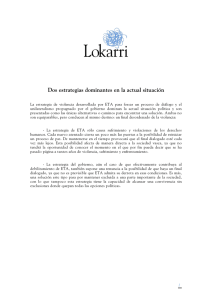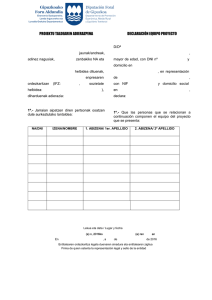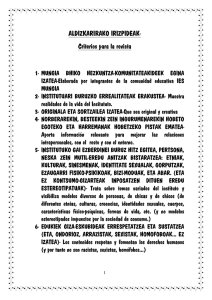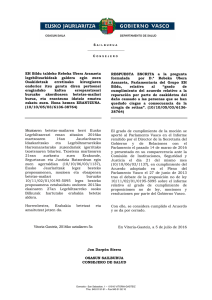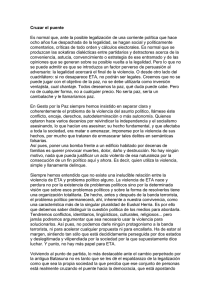FRANCISCO HIDALGO de CISNEROS
Anuncio
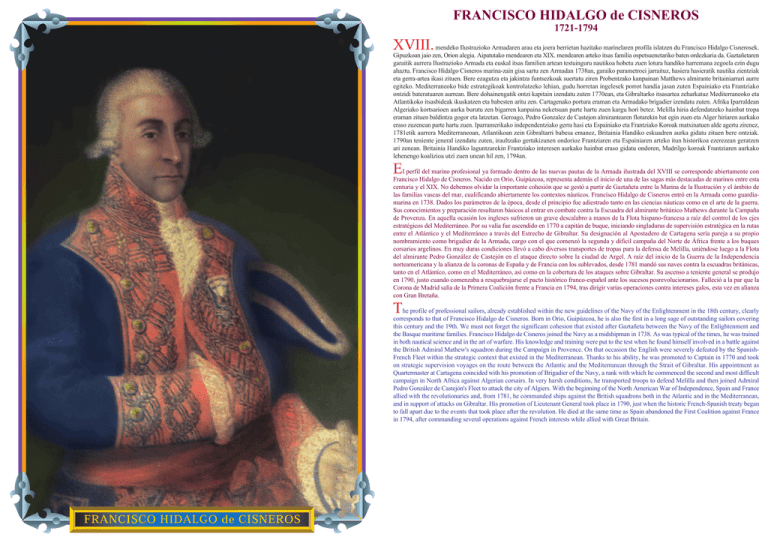
FRANCISCO HIDALGO de CISNEROS 1721-1794 XVIII. mendeko Ilustrazioko Armadaren arau eta joera berrietan hazitako marinelaren profila islatzen du Francisco Hidalgo Cisnerosek. Gipuzkoan jaio zen, Orion alegia. Aipatutako mendearen eta XIX. mendearen arteko itsas familia ospetsuenetariko baten ordezkaria da. Gaztañetaren garaitik aurrera Ilustrazioko Armada eta euskal itsas familien artean testuinguru nautikoa hobetu zuen lotura handiko harremana zegoela ezin dugu ahaztu. Francisco Hidalgo Cisneros marina-zain gisa sartu zen Armadan 1738an, garaiko parametroei jarraituz, hasiera hasieratik nautika zientziak eta gerra-artea ikasi zituen. Bere ezagutza eta jakintza funtsezkoak suertatu ziren Probentzako kanpainan Matthews almirante britainiarrari aurre egiteko. Mediterraneoko bide estrategikoak kontrolatzeko lehian, gudu horretan ingelesek porrot handia jasan zuten Espainiako eta Frantziako ontzidi bateratuaren aurrean. Bere dohainengatik ontzi kapitain izendatu zuten 1770ean, eta Gibraltarko itsasartea zeharkatuz Mediterraneoko eta Atlantikoko itsasbideak ikuskatzen eta babesten aritu zen. Cartagenako portura eraman eta Armadako brigadier izendatu zuten. Afrika Iparraldean Algeriako kortsarioen aurka burutu zen bigarren kanpaina neketsuan parte hartu zuen kargu hori betez. Melilla hiria defendatzeko hainbat tropa eraman zituen baldintza gogor eta latzetan. Geroago, Pedro Gonzalez de Castejon almirantearen flotarekin bat egin zuen eta Alger hiriaren aurkako eraso zuzenean parte hartu zuen. Iparramerikako independentziako gerra hasi eta Espainiako eta Frantziako Koroak matxinatuen alde agertu zirenez, 1781etik aurrera Mediterraneoan, Atlantikoan zein Gibraltarri babesa emanez, Britainia Handiko eskuadren aurka gidatu zituen bere ontziak. 1790an teniente jeneral izendatu zuten, iraultzako gertakizunen ondorioz Frantziaren eta Espainiaren arteko itun historikoa ezerezean geratzen ari zenean. Britainia Handiko laguntzarekin Frantziako interesen aurkako hainbat eraso gidatu ondoren, Madrilgo koroak Frantziaren aurkako lehenengo koalizioa utzi zuen unean hil zen, 1794an. E l perfil del marino profesional ya formado dentro de las nuevas pautas de la Armada ilustrada del XVIII se corresponde abiertamente con Francisco Hidalgo de Cisneros. Nacido en Orio, Guipúzcoa, representa además el inicio de una de las sagas más destacadas de marinos entre esta centuria y el XIX. No debemos olvidar la importante cohesión que se gestó a partir de Gaztañeta entre la Marina de la Ilustración y el ámbito de las familias vascas del mar, cualificando abiertamente los contextos náuticos. Francisco Hidalgo de Cisneros entró en la Armada como guardiamarina en 1738. Dados los parámetros de la época, desde el principio fue adiestrado tanto en las ciencias náuticas como en el arte de la guerra. Sus conocimientos y preparación resultaron básicos al entrar en combate contra la Escuadra del almirante británico Mathews durante la Campaña de Provenza. En aquella ocasión los ingleses sufrieron un grave descalabro a manos de la Flota hispano-francesa a raíz del control de los ejes estratégicos del Mediterráneo. Por su valía fue ascendido en 1770 a capitán de buque, iniciando singladuras de supervisión estratégica en la rutas entre el Atlántico y el Mediterráneo a través del Estrecho de Gibraltar. Su designación al Apostadero de Cartagena sería pareja a su propio nombramiento como brigadier de la Armada, cargo con el que comenzó la segunda y difícil campaña del Norte de África frente a los buques corsarios argelinos. En muy duras condiciones llevó a cabo diversos transportes de tropas para la defensa de Melilla, uniéndose luego a la Flota del almirante Pedro González de Castejón en el ataque directo sobre la ciudad de Argel. A raíz del inicio de la Guerra de la Independencia norteamericana y la alianza de la coronas de España y de Francia con los sublevados, desde 1781 mandó sus naves contra la escuadras británicas, tanto en el Atlántico, como en el Mediterráneo, así como en la cobertura de los ataques sobre Gibraltar. Su ascenso a teniente general se produjo en 1790, justo cuando comenzaba a resquebrajarse el pacto histórico franco-español ante los sucesos posrevolucionarios. Falleció a la par que la Corona de Madrid salía de la Primera Coalición frente a Francia en 1794, tras dirigir varias operaciones contra intereses galos, esta vez en alianza con Gran Bretaña. T he profile of professional sailors, already established within the new guidelines of the Navy of the Enlightenment in the 18th century, clearly corresponds to that of Francisco Hidalgo de Cisneros. Born in Orio, Guipúzcoa, he is also the first in a long sage of outstanding sailors covering this century and the 19th. We must not forget the significant cohesion that existed after Gaztañeta between the Navy of the Enlightenment and the Basque maritime families. Francisco Hidalgo de Cisneros joined the Navy as a midshipman in 1738. As was typical of the times, he was trained in both nautical science and in the art of warfare. His knowledge and training were put to the test when he found himself involved in a battle against the British Admiral Mathew's squadron during the Campaign in Provence. On that occasion the English were severely defeated by the SpanishFrench Fleet within the strategic context that existed in the Mediterranean. Thanks to his ability, he was promoted to Captain in 1770 and took on strategic supervision voyages on the route between the Atlantic and the Mediterranean through the Strait of Gibraltar. His appointment as Quartermaster at Cartagena coincided with his promotion of Brigadier of the Navy, a rank with which he commenced the second and most difficult campaign in North Africa against Algerian corsairs. In very harsh conditions, he transported troops to defend Melilla and then joined Admiral Pedro González de Castejón's Fleet to attack the city of Algiers. With the beginning of the North American War of Independence, Spain and France allied with the revolutionaries and, from 1781, he commanded ships against the British squadrons both in the Atlantic and in the Mediterranean, and in support of attacks on Gibraltar. His promotion of Lieutenant General took place in 1790, just when the historic French-Spanish treaty began to fall apart due to the events that took place after the revolution. He died at the same time as Spain abandoned the First Coalition against France in 1794, after commanding several operations against French interests while allied with Great Britain.

